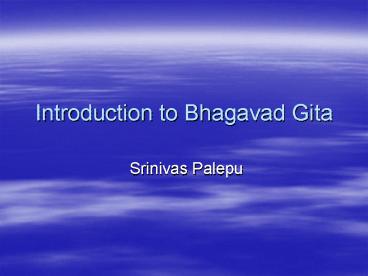Introduction to Bhagavad Gita - PowerPoint PPT Presentation
1 / 22
Title:
Introduction to Bhagavad Gita
Description:
Knowledge passed verbally from teacher to disciples. Upanishads ... Equipoise: Be a kind friend to all living entities, equal in both happiness and ... – PowerPoint PPT presentation
Number of Views:4186
Avg rating:3.0/5.0
Title: Introduction to Bhagavad Gita
1
Introduction to Bhagavad Gita
- Srinivas Palepu
2
History
- Vedas
- Knowledge passed verbally from teacher to
disciples - Upanishads
- Sophisticated philosophy emanated from truths
revealed during meditations
3
Ved Vyasa
- A guru of high order around 4000 years ago
- His main contributions
- Documented all Vedas in a book form
- Documented Upanishads
- Wrote Mahabharata
- Wrote Bhagavad Gita (around 700 verses)
- Wrote Srimad Bhagavatam (around 10,000 verses)
4
Context of Bhagavad Gita
- Battleground
- War between Pandavas and Kauravas
- Dialogue between Krishna and Arjuna
- Arjunas confusion between war and harmony
- Krishnas sermon to Arjuna about Yoga
5
Famous Acharyas
- Sankaracharya
- Ramanujacharya
- Madhavacharya
- Chaitanya Mahaprabhu
6
Modern publications
- Written by scholarly gurus
- Sanskrit verses are all original from Veda Vyasa
- Each guru has written his own commentary and in
some cases their own word-to-word translation of
Sanskrit verses into prose in English
7
Some Famous Modern Publications
- Bhagavad-Gita As It Is by A. C. Bhaktivedanta
Swami Prabhupada (Hardcover - Mar 1, 1997) - Gita Bhasya by Sri Ramanuja
8
What does Gita talk about?
- The Reality
- The Goal
- The Means
9
The Text
- Eighteen chapters
- Can be divided into three sections of six
chapters each
10
Summary of Bhagavad Gita
- Five Basic Truths
- Isvara, the Supreme Lord
- Jiva, the living entity
- Prakriti, the material nature
- Kala, the time
- Karma, the activity
- The first four are eternal, Karma is not
11
Isvara
- The Supreme Controller and Supreme Consciousnesss
- Called by different names, Krishna, Lord, Brahman
being some such names - The Super-Soul
- The greatest of all
- Has control over the universal affairs of
material nature
12
Jiva
- The controlled (we all!)
- The soul
- Is conscious (only of ones own body, whereas
Isvara is conscious of bodies of all jivas) - Like supreme controller (have all the qualities
of the controller) but not the same (quantity is
too minute) - Parts and parcels of the Lord
- Our tendency to control everything is there
because it is there in Isvara. But we should
remember that Isvara is the Supreme Controller,
not we - It is also called Superior Prakriti
13
Prakriti
- Material nature or inferior Prakriti
- Is not independent
- Is not conscious
- Is working under the directions of the Supreme
Lord - Is always under the control by Isvara
- Three qualities mode of goodness, passion and
ignorance (good, bad and ugly!) - Manifestation of prakriti is temporary but is not
false
14
Kala
- The duration of existence of the whole universe
or the manifestation of material nature
15
Karma
- The activity
- Is not eternal
- Effects are very old indeed
- We are suffering or enjoying the results of our
activities from time immemorial - Changing the results of our karma depends on the
perfection of our knowledge
16
Goal
- Sustainable Happiness
- sustainable across lives
- In full awareness
- Cognizant of the truths
17
Means
- Prescribed duties of sacrifice, charity and
penance, according to ones nature, are not to be
given up they must be performed and their result
renounced. Then one has no results to enjoy or
suffer. Duties prescribed according to ones
nature are never affected by sinful reactions.
18
Means
- Equipoise Be a kind friend to all living
entities, equal in both happiness and distress,
tolerant, self-controlled, free from false ego
and envy and be always engaged in devotional
service with determination
19
Means
- Be aware of the three modes of material nature
(ie, Goodness, Passion and Ignorance) in
knowledge, action, determination, happiness and
work. - The knowledge by which one undivided spiritual
nature is seen in all living entities action
without love or hatred clear understanding of
what is to be done and what is not to be done
yogic determination that controls activities of
mind, life and senses happiness which awakens
one to self-realization are all in the nature of
goodness.
20
Means
- All roads lead to devotion and ultimately
surrender Gnanis, after attaining supreme
perfectional stage, Brahman, by being determined
and free from false notions, become equally
disposed towards every living being and thus
attain pure devotional service to Lord - Surrender unto Lord
21
How to get deeper into Bhagavad Gita?
- Like any other subject, read more and more and
more
22
Some Best Practices on how to read Bhagavad Gita
- First 36 days Chapter a day of just the
translation prose (15-20 minutes per day in the
morning) from Prabhupadas book - Read 18th Chapter complete with Purport from
Prabhupadas book - Recite a chapter a day from Prabhupadas book
(Sanskrit verses) - Read all chapters with purport and analyze deeper
- Attend a study-group in your locality































